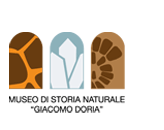The petrographic and mineralogical collection of Lorenzo Pareto was the first core of the Museum's abiological collections, as it was already in its possession at the time of its foundation in 1867.
In 1872, Giovanni Battista Traverso donated the first, and still today most important, mineralogical collection of the Museum, initially comprising 1,200 Italian minerals, eventually rising to 5,000. The collection is particularly rich in materials from Sardinia, since Traverso long held the position of Director and manager at various Sardinian mines.
From 1906 Alberto Pelloux began collaborating with the Museum and he reorganised and described the Traverso collection. In 1920 he was appointed Honorary Conservator of the Museum, managing the mineralogical section, which he increased by donating several duplicates from his own collection.
In 1940, the Society of Friends of the Museum bought the collection of Gabriele Lincio, consisting of about 2,000 specimens of minerals and rocks.
Except for the small collections of Roberto Uziel (donated at the end of the 19th century) and Gustavo De Amezaga (700 specimens arrived in 1936), no significant increases occurred for a few decades.
In 1987 the important collection of Paolo Onofrio Tiragallo was purchased, consisting of 10,000 specimens mainly of Ligurian origin.
Some Sardinian minerals were donated by Paolo Stara in 1989, while some unused didactic collections were also donated by Genoese schools.
In 2000 and 2001 the Museum also purchased the collections of Sergio Amisano (1,200 specimens) and Nino Sanfilippo (1,270 specimens), who had previously collaborated to cataloguing the collection of his colleague Tiragallo and reinstating part of this collection damaged following the 1992 flood.
The Museum collection includes about 25,000 specimens recently partially studied by Cristina Carbone and Donato Belmonte (Genoa University), who in 2015 assisted the Museum scientific staff in the setup of the new permanent exhibition.




